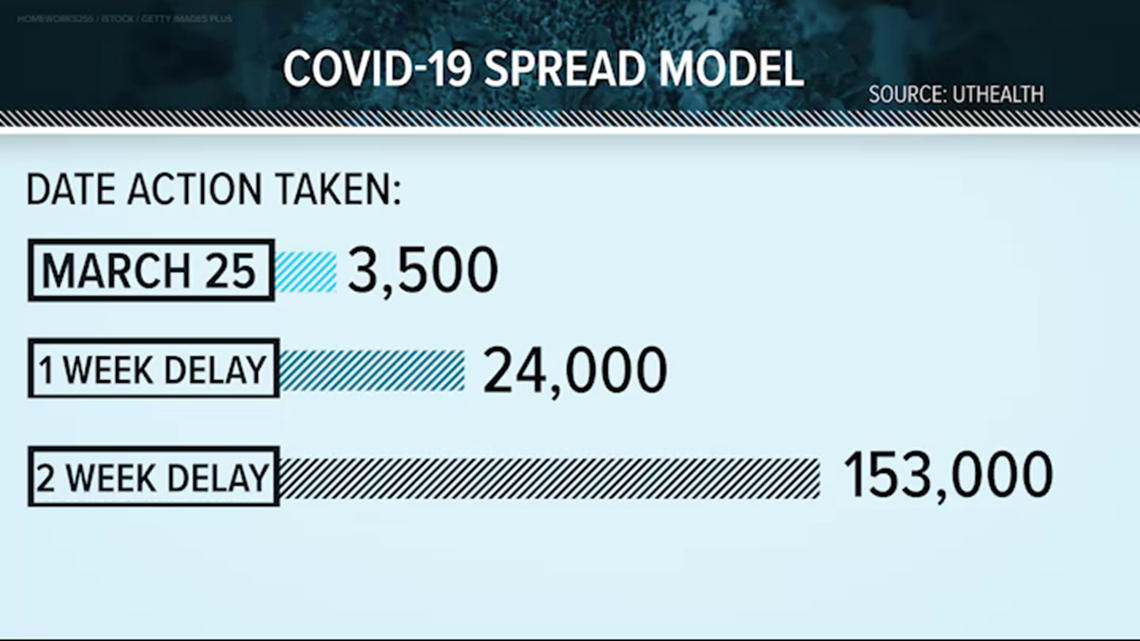HARRIS COUNTY, Texas — New research projects the total number of Houston-area COVID-19 cases at a few thousand now that stay-at-home orders are in effect. But without that intervention, those who test positive could fill NRG stadium—twice.
Eric Boerwinkle, dean of the UTHealth School of Public Health, leads a team who applied artificial intelligence methods to real coronavirus case data from China and Italy. The researchers then modeled the potential spread in 150 counties around the world, then here at home.
The findings were used by Harris County Judge Lina Hidalgo in her decision to issue the stay-at-home order Tuesday.
She said Boerwinkle “informed us—very alarmingly—yesterday we must take steps now. Any delay in additional action would be incredibly problematic. The models he has produce require us … to take additional aggressive steps.”
The models also help to answer questions on everybody’s mind.
“How long is this infection going to last in Houston? And at the end, how many cases will there be?” Boerwinkle said.


Researchers estimate with the strict intervention measures now in place, the number of coronavirus cases could grow to around 3,500 in the greater Houston area. But if the intervention was delayed one week, the number would rise to about 24,000 cases.
If delayed two weeks, cases would climb to 153,000.
“It is astounding, and I think it’s the reason why the judge and the mayor took this extraordinary action,” Boerwinkle said.
UTHealth researchers also forecast when the virus will peak locally, estimating that will occur around April 7 with around 1,800 cases at that time. The anticipated end of the infection would be around May 12 in the Houston area.
That forecast will help hospitals, clinics and physicians to plan accordingly in the coming weeks, according to Boerwinkle.
He emphasized that the projections are a forecast.
“We are in unprecedented times, there’s no doubt about it and there’s a lot of anxiety out there,” Boerwinkle said. “But again, it’s not just a theoretical model that’s based on parameters that we have no idea what they are.”
After Tuesday’s stay-at-home order was announced, Boerwinkle and the UTHealth research team began to tackle another projection—how long should public officials continue the strict measures.
“I don’t know the answer to that, but when we do know the answer I would love to talk to you again,” he said.
Coronavirus symptoms
The symptoms of coronavirus can be similar to the flu or a bad cold. Symptoms include a fever, cough and shortness of breath, according to the Centers for Disease Control.
Most healthy people will have mild symptoms. A study of more than 72,000 patients by the Centers for Disease Control in China showed 80 percent of the cases there were mild.
But infections can cause pneumonia, severe acute respiratory syndrome, kidney failure and even death, according to the World Health Organization. Older people with underlying health conditions are most at risk.
The CDC believes symptoms may appear anywhere from two to 14 days after being exposed.
Human coronaviruses are usually spread through...
- The air by coughing or sneezing
- Close personal contact, such as touching or shaking hands
- Touching an object or surface with the virus on it, then touching your mouth, nose or eyes before washing your hands.
Help stop the spread of coronavirus
- Stay home when you are sick.
- Eat and sleep separately from your family members
- Use different utensils and dishes
- Cover your cough or sneeze with your arm, not your hand.
- If you use a tissue, throw it in the trash.
Lower your risk
- Wash your hands often with soap and water for at least 20 seconds. If soap and water are not available, use an alcohol-based hand sanitizer.
- Avoid touching your eyes, nose, and mouth with unwashed hands.
- Avoid close contact with people who are sick.
- Clean and disinfect frequently touched objects and surfaces.
- If you are 60 or over and have an underlying health condition such as cardiovascular disease, diabetes or respiratory illnesses like asthma or COPD, the World Health Organization advises you to try to avoid crowds or places where you might interact with people who are sick.
Get complete coverage of the coronavirus by texting 'FACTS' to 713-526-1111.

